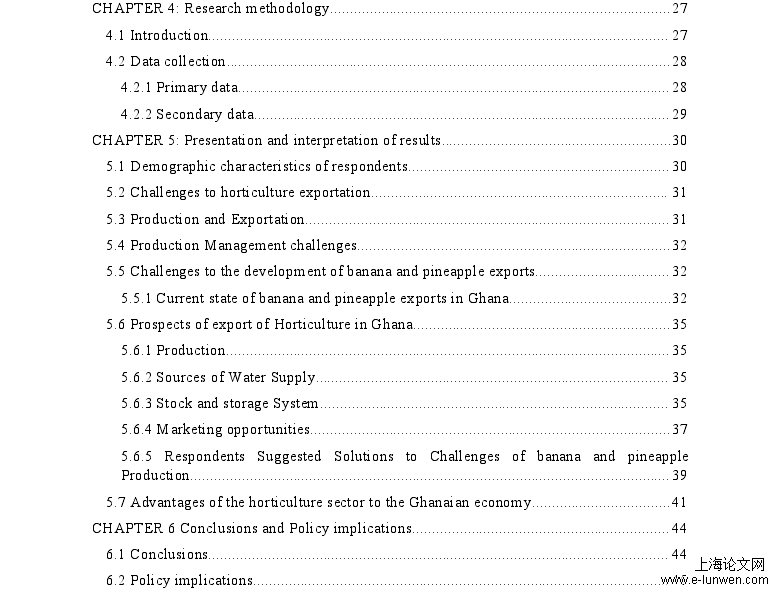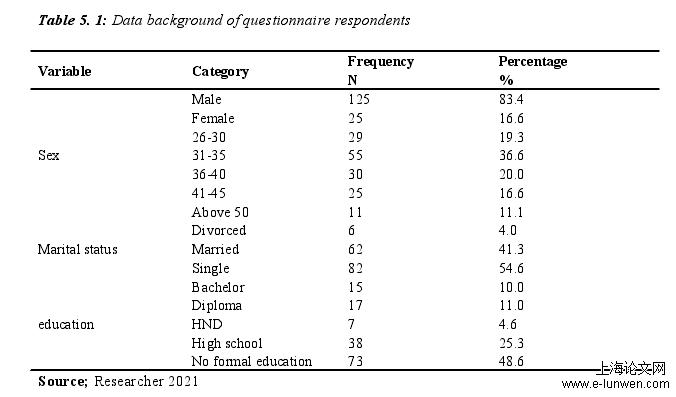电子商务论文哪里有?本研究将提供有关大阿克拉地区香蕉和菠萝生产和出口的前景、挑战和应对挑战的措施的相关信息。研究结果可能对农民、出口商和加工商有用。此外,它还将有助于非政府组织、加纳政府、捐助者和参与为农民规划园艺发展方案以提高产量提供技术援助的机构。
CHAPTER 1 : Introduction
2.2 Theoretical literature
This section briefly highlights the most referred theories of trade and made attempts to linkthem with agriculture, which takes lion's share of Sub-Saharan African (SSA) countries’ trade.
2.2.1 New Trade’ Theory
Following the Ricardian, H-O, NTT, and IIT models, the modern ‘new trade theory' (NTT)emphasizes that trade is mainly conducted with homogeneous goods (equal in productivity).IIT emphasized that trade in homogeneous products occurs primarily in developed countries,while inter-industry trade in heterogeneous products occurs in both developed and developingcountries. Agricultural markets, according to NTT, are often subjected to imperfectcompetition from the downstream or upstream sectors. Along the supply chain, farm goodsare modeled as distinct and monopolistic rivalry. The NTT, on the other hand, has one majorflaw: it is based on the premise of a representative firm (Krugman, 1980), which is at oddswith fact.
Firms are typically heterogeneous rather than homogeneous, meaning that their productivitiesdiffer. Melitz (2003) is widely regarded as a pioneer in the study of the effects of firmheterogeneity on international trade. The NTT was established as a result of Melitz's efforts.Melitz emphasizes the importance of firm heterogeneity as a source of comparative advantage. Despite the fact that, on average, no firm in a given sector is profitable enough toexport due to the dispersion of its productivities. Nonetheless, there might be a fewcompanies left that can produce enough to export. This insight is significant as it yields anexplanation for the reason nation’s even exports or imports in sectors where they appear tohave a comparative advantage or disadvantage. The other major impetus of Melitz model isthat free trade does not only lead to resource reallocations within sectors, but also betweensectors; resources are mostly reallocated from least productive companies to higherproductive firms. Otherwise small firms and exporters will be forced to fold up as they couldnot compete favorably with the larger firms in the market, at least in the short run. Melitz(2004), nonetheless, stresses that domestic protections of infant industries would impedeproductivity; lowering protections may stimulate healthy competition and higher productivity.As with NTT, there is now a discussion about the applicability of NNTT to agriculture. Forinstance, Gopinath Sheldon and Echeverria (2007) try to address this subject in a broadcontext. They argue in favor of NNTT. Their studies show that there might not be a directexport decision on agriculture in comparison with other industries. Notwithstanding, theremay be an underlying decision in agricultural trade.

电子商务论文
..........................
CHAPTER 3: Overview of Ghana’s banana and pineapple sector
3.1 Banana and pineapple in Ghana
Since some major processing and exporting companies struggle to get raw materials toprocess and/or export, declining productivity in the fruit production industry have become amajor concern in Ghana. As a result, the majority of these businesses have closed or movedto other countries, resulting in job losses in both rural and urban areas. The industry'sinability to meet export demand has resulted in a loss of international market share andforeign exchange, both of which the country desperately needs. Our research into finding andevaluating new ways to improve farmer productivity in the fruit industry is a significant stepforward in light of the aforementioned issues.
Upon the general declining trend of the agricultural sectors contribution to GDP, thehorticulture sub-sector has since been progressing steadily in the country. A report fromgepcghana.com indicates that, from 1997, Ghana's fruits exports have increased dramatically.The majority of these fruits exports, which are sent to the world market by air and sea, arepineapples and citrus fruits. By connecting fruits exporters to the SPEG, the government hastaken constructive measures to assist them. This allows a ship to dock in Tema, where theexport is loaded into one or more holds and then transported. Ghana exports over 70,000 tonsand more of pineapple and banana each year. The sector's expansion has been drivenprimarily by private-sector entrepreneurs with creative ideas. Despite the fact that pineapplecultivation and exporting continue to draw businessmen looking for a fast profit, With thearrival of a greater number of daily exporters, the industry is maturing (Ghana exportpromotion Authority, 2016). Smaller players, such as Tongu Farms in the Volta region andBomarts, have also made significant investments in the hopes of rapidly growing their output.
..........................
CHAPTER 5: Presentation and interpretation of results
5.1 Demographic characteristics of respondents
This section analyzes the survey responses. The chapter comprises different sub sections.Section two to four describes the characteristics of the respondents, namely, gendercomposition, educational background and marital status. Section five describes the trends inpineapple production while the sixth section ascertains why people go into pineappleagriculture. The last two sections assess how profitable pineapple farming is, as well as howprofitable it is to grow pineapples investigates its impact on livelihood.
As shown by Table 5.1, there were more male participant (83.4 percent) in the survey thanfemale (16.6 percent).
When evaluating the productivity of the labor force, age is crucial. Just 19.3 percent of therespondents were found to be between the ages of 26 and 30, while 20 percent are betweenthe ages of 36 and 40, according to Table 5.1. 16.6 percent, and 11.1% of those aged 41 to 45and over 50 years old, respectively. This indicates that the majority of farmers and marketagents in the region are in their thirties and fifties (i.e., 31 to 50).

Table 5. 1: Data background of questionnaire respondents
............................
5.2 Challenges to horticulture exportation
In this section analysis of production, management, marketing and growth challenges ofbanana and pineapple is presented. A general analysis has also been made on other factorsinhibiting Banana and pineapple production which include drought, diseases, bushfires, theft,accidents and storage challenges. With regard to the production, management and marketingchallenges, respondents were asked to indicate their level of agreement with the challengesthey face in their fruit business. Frequencies and percentages were used to present the results.
The results on production challenges are presented in table 4.9. Respondents were asked toindicate their level of agreement with statements regarding challenges in their crops. As canbe seen indicated in Table 4.9., majority (94%) of the growers strongly agreed that it wasdifficult growing young banana and pineapple plants.
Overwhelming number (97%) of the farmers agreed to the statements that they find itdifficult to treat infested banana and pineapple respectively in the Districts, which does affectproductivity.
......................
CHAPTER 6 Conclusions and Policy implications
6.2 Policy implications
Ghana's impressive economic success is still reliant on an increase in agricultural exports thatis sustained and important. While much progress has been made in developing thenontraditional agricultural sector, with pineapple as the leading crop, there are still a numberof obstacles to overcome in order for the sector to continue to develop. Finally, Ghana'sagricultural export prospects, especially in the horticultural sub-sector, will be decided bycontinued policy reforms in promoting export development and Ghana's ability to compete ininternational markets by offering these products market fair prices.
To increase export amount, Ghanaian farmers must improve their production. This wouldencourage more shipping companies to transport cargo from Ghana, reducing theirdependence on leftover space on ships from other countries. This will also help to increasecompetition and lower freight costs. SPEG's position should be expanded to includepineapple growers as well.
Other horticultural exporters' organizations, such as the Banana Exporters' Organization,should also play a bigger role. Collaboration between SPEG and other groups should beencouraged. This will enable them to pursue their objectives. The existing trend of the GPHAmaking all infrastructure investments while their private partners only run the facilities has a negative impact on the port's competitiveness and performance. In light of this, we agree withRnnevik's (2009) proposal that ports with a throughput of more than 100 000 TEUs, such asTema’s, should promote and provide incentives to private operators to invest in infrastructure.This would not only reduce the port's reliance on government funds, but also help to spreadinvestment risks and increase efficiency.
reference(omitted)

